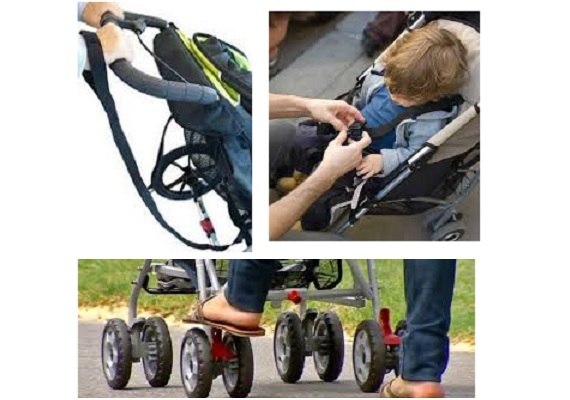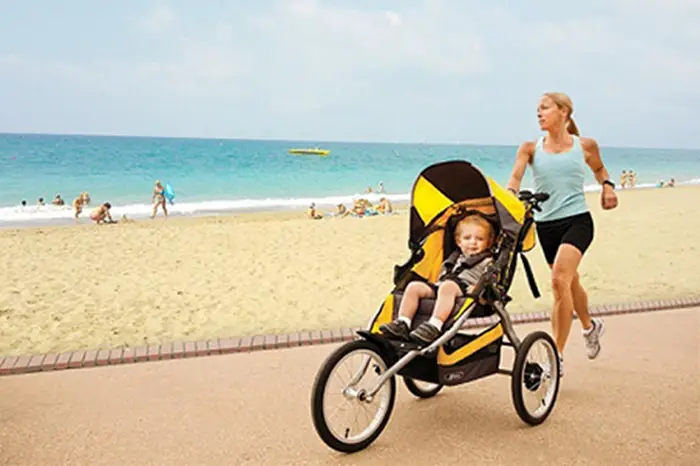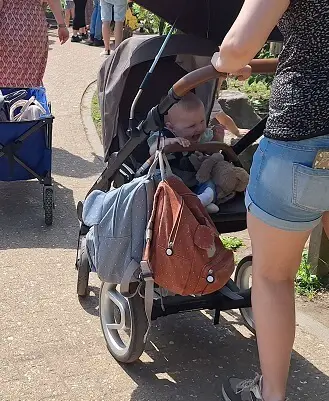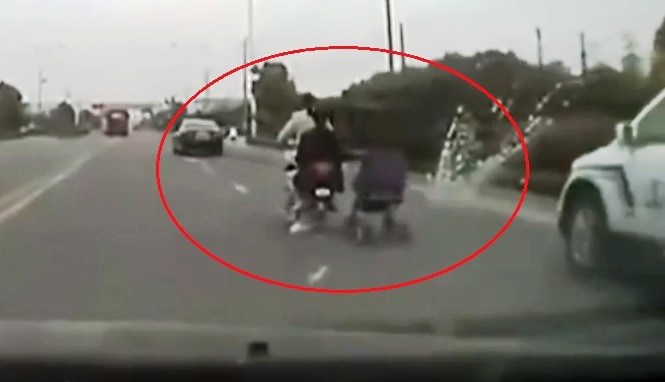
we may earn an affiliate commission. Learn more.
In general, strollers by themselves are not hazardous products and have several safety features built-in; they follow safety standards laid down by concerned authorities. But when injuries occur, they can be quite serious.
So, make sure you follow these safety measures and good practices.
Safety Features
Use the Safety Harness
As per studies published by the Consumer Product Safety Commission (CPSC) and American Academy of Pediatrics (AAP), the number one reason for injuries while strolling is caused due to the baby falling from the stroller, mostly resulting due to the baby not restrained with safety harness.
 Today, you won’t find any stroller that is without a safety harness.
Today, you won’t find any stroller that is without a safety harness.
The best strollers offer a 5-point harness with easy-to-use latching mechanism. So, make sure you use the harness at all times to keep your baby safe and secure.
Buckle up your child every time they are in the stroller.
Read: Best universal stroller straps/harness belts
Keep Baby Away When Folding
In the past, strollers from top brands have been recalled following reports of fingertip amputations. There is a possibility that a baby’s fingertips can get pinched in the hinge of the stroller (while folding it) leading to serious injuries.
It is always recommended that you keep your baby away while folding or unfolding the stroller.
Make Sure It is Locked After Unfolding
Unfolding is only half the job done. Make sure you hear the reassuring click sound that indicates that the stroller is fully locked and ready to use. When you don’t unfold without the click, the stroller may collapse with the baby’s weight causing injuries to the child.
Double Check the Parking Brake
Can you imagine the disaster that can happen if the parking brakes on a stroller are not applied?
You have to be alert while traveling in public transport or crowded areas such as a train station or a busy road.
 Always remember to put on the brakes, every time the stroller is parked, or you need to rest your hands. Most even surfaces do have some slope/incline and the stroller could just roll away.
Always remember to put on the brakes, every time the stroller is parked, or you need to rest your hands. Most even surfaces do have some slope/incline and the stroller could just roll away.
So don’t forget to apply the brakes, even on a flat surface so that your baby can’t get the wheels moving again.Lock the stroller wheels when you “park” it, prevents the stroller from rolling away unexpectedly.
Stay close to the stroller as much as possible
Even though strollers come with brakes, it is recommended that you do not leave the child unattended in the stroller for long.
You should also train your older child to keep an eye on the stroller (if you move away for a while) but from a distance (no touching or pushing the stroller).
Avoid Using the Elevator
Falling may cause minor injuries to the baby but a fall from stairs and escalators are equally dangerous.
My advice would be to avoid taking the stroller on escalators or stairs and stick to using an elevator instead. Or you could ask for help to carry the stroller over the stairs or carry the baby in your hand while climbing up and down the stairs and have someone else get the empty stroller.
In case, you do not have an option, be careful while navigating stairs and escalators in malls. Balance the stroller on each step to prevent it from tipping over or slipping.
Don’t Run Unless It’s a Jogger
 Standard size strollers are not designed for jogging and running activities.
Standard size strollers are not designed for jogging and running activities.
For jogging, always use a jogging stroller and take the baby only once they have crossed the minimum age requirement that is specified by the manufacturer.
Check for faulty or loose partsRegularly check the stroller for faulty or loose parts to avoid accident or injury. Regularly clean the stroller and also inspect the stroller, especially the wheels and brakes. The wheels need to be in good condition to keep your child safe with every ride.
Check the Position of the Cup Holder
While hot beverages can be placed in the cup-holder, make sure the cup holder is positioned properly in the stroller, and is deep enough so that the baby is not harmed in anyway.
Cupholders are usually shallow and if the hot beverage spills over on the child, it could cause serious burn injuries.
Also, make it a rule to not have hot liquids while pushing the stroller and do not balance your hot beverage cup in one hand and your baby in another hand, which is a sure way to cause accidents.
Don’t Hang Anything Heavy from the Handlebar
 Do not hang anything heavy from the handle-bar as it could cause the stroller to tip-over. A back-tip especially is dangerous and can cause injuries to the baby’s head since the baby is more likely to fall on their head.
Do not hang anything heavy from the handle-bar as it could cause the stroller to tip-over. A back-tip especially is dangerous and can cause injuries to the baby’s head since the baby is more likely to fall on their head.
As much as possible, keep things in the pockets and storage area underneath the stroller to prevent the stroller from tipping. And always keep the child securely fastened when seated in the stroller.
Using Blankets over Stroller
Putting blanket over Stroller or Car Seat in hot summer is a strict no. It can cause temperature to rise significantly and can be lethal.
Buying a ‘Used’ stroller
Although secondhand / used strollers offer good value, thoroughly check if the essential components such as the seat belt, brakes and wheels are in good condition. Look for gaps that could catch toes and small fingers. Also, make sure it is not very old.
Preferably, buy the latest strollers that come with better built-in safety features, they are are sturdy, reliable and safe. These adhere to the latest safety standards.
Go for higher safety ratings
In the past, several cases of injuries to children have been reported due to problems with strollers.
So, choose strollers with maximum safety rating. Usually, the safety features co-relate to the price, so you are more likely to get what you pay for.
It means you should avoid going very cheap.
Buy strollers that are made after September 10, 2015, as they will have the recommended safety features built-in, such as structural integrity, hinges, seat belts, wheels, brakes, and latch locks.
Know the Stroller Features
There are various types and models of Strollers, but before choosing one, make sure it has adequate safety features built-in.
Know the various parts & features of your stroller. Also go through this detailed stroller buying guide
Stroller Accidents: Be Careful Near Slopes, Tracks, Motorways
Here’s why, as parents or caretakers, you have to be extremely careful when you’re near railway tracks or are on a slope, and have to manage a baby in the stroller.
Here are several examples where the caretakers momentarily looked away, assuming that the baby stroller was stationed safely, only to be horrified to see the baby stroller roll onto the train tracks.
Fortunately, in all these cases, no trains were around at that time and the parents and bystanders were quickly able to retrieve the strollers in the nick of time. Although in one of the cases, the girl toppled over the edge, plunging head-first onto the tracks. She was later treated for injuries to her face.
Baby in stroller falls onto train tracks in Philadelphia
Stroller With Baby Falls Underneath Moving Train in Australia
Wind blows stroller with baby onto Train Tracks in London, Mom scrambles to save the little one.
And it all happens because the parent looked away for a matter of seconds, when the stroller rolled down the sloping platform. So the next time you’re at a station or crossing the road, be very careful.
Man saves toddler rolling downhill in stroller. Another reason why one needs to be very careful while on a slope.
Speechless! #Superhuman pic.twitter.com/XIZEy7hy8Y
— Vibhinna Ideas (@Vibhinnaideas) September 19, 2020
Reckless mother with pram and toddler takes shortcut across busy motorway
Shocking footage captures moment a mother crosses busy road with kids
She has a pram and leads toddler as cars reach speeds of 40mph
Lorry driver’s Dash cam filmed the reckless crossing on motorway in Manchester
The driver said it was ‘unbelievable’ and that they were close to being hit
A witness said the woman lifted the toddler over the barrier before going through herself with her baby. In the video, you can see the mother trying to squeeze through a small gap in the the barrier, attempting to cross the Mancunian Way. She is dangerously close to fast cars on the busy stretch in Manchester city centre.
“I couldn’t believe what I was seeing. The child was smaller than the barrier, she couldn’t see over it. There were cars whizzing past, accelerating up to 50mph. It was unbelievable,” said the HGV driver who captured the footage.
The video even shows a BMW driving past the child, she could have so easily been hit.
Mother tows baby stroller while riding on scooter

A video was uploaded on YouTube that showed a lady on a scooter towing a baby carriage across a busy road. Viewers were horrified to see it and said things like ‘most horrible parenting.’
Can you believe this video?!
However, its not clear whether or not there was actually a child sitting in the stroller.
Lets hope there wasn’t (lets assume the woman had that much common sense).
The woman attempts to cross three lanes of traffic, narrowly missing a sedan. She lets the car pass, then makes her way to the furthest-right lane…meant for slow moving vehicles of course.
This video indeed caught my breath. I just hope there was no child in that stroller, and no one was hurt (towing the stroller with a baby is definitely a no-no).
But on the other hand, if the idea was to transport an empty stroller, then its indeed an innovative idea.
What do you guys think?
StrollerBoards is a family managed website with me (Ben) and my wife doing most of the work. We are proud parents of two wonderful kids and love reviewing baby travel gear. We have a firm but friendly “democratic parenting” style and offer several practical solutions backed by extensive research. Our own experience with raising two children prompted us to share our knowledge. Read more.
Leave a Reply